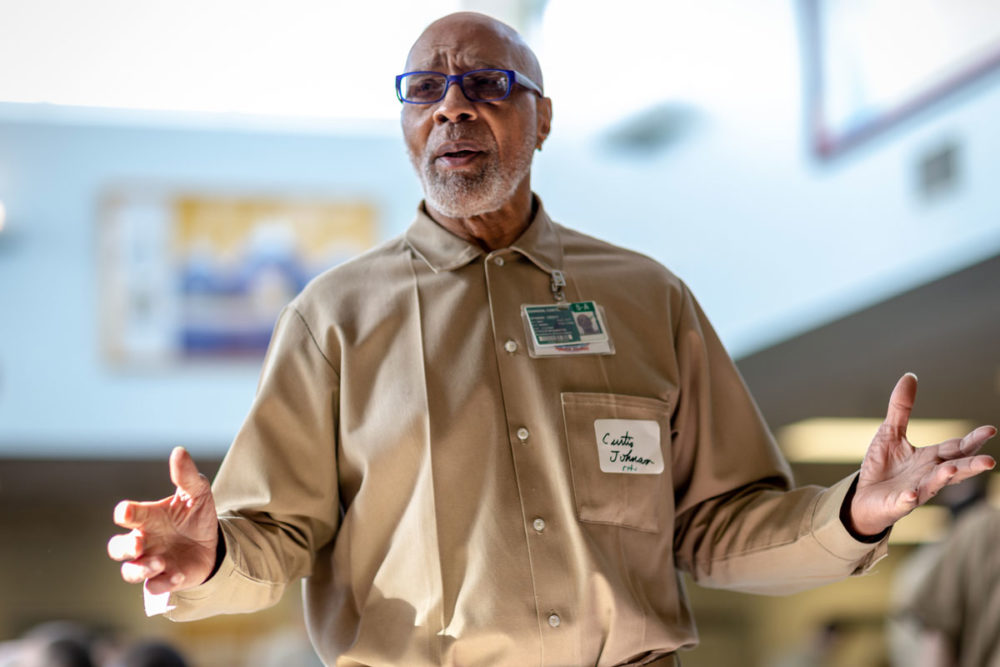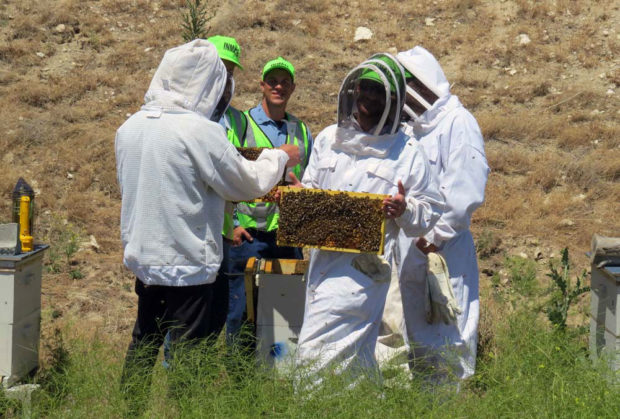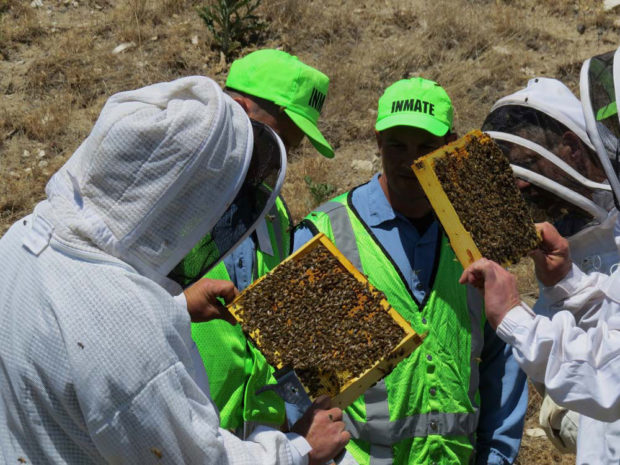By Rachel Friederich, DOC Communications
Originally published July 31, 2019, in DOC Communications newsroom; reposted here with permission


POULSBO – Violet Garcia crouches among rows of lush, green kale and lettuce. Her tan work shoes are caked with dirt, evidence of her hard work.
Between her gloved fingers is a robust bundle of green onions. She smiles as she trims back their long roots with a pair of garden shears.
“I’m giving them a haircut,” Garcia, 37, says. “I didn’t know green onions could get this big!”

The project is called the GRACE garden. The acronym GRACE stands for Gardening for Restoration and Conservation Education. Besides the food bank, the garden is used as an educational demonstration garden for community groups.
Garcia is one of five incarcerated women who have traveled from the Belfair, Washington prison, Mission Creek Corrections Center for Women to a garden in Kitsap County. The work crew does all the planting, weeding and harvesting of produce, which is given to the Central Kitsap Food Bank.
Solving a Problem
It’s all part of a partnership the Department of Corrections has with the Kitsap Conservation District.
Last year, the district opened the garden, a project made possible by a $50,000 grant from the National Association of Conservation Districts. The grant focuses on projects that reduce food insecurity and address food deserts.

Food insecurity describes a household’s inability to provide enough food for every person to live an active, healthy life. Approximately 11.6% of Kitsap County’s population, or 30,000 people, experienced food insecurity in 2017, according to data collected by Feeding America, the nation’s largest domestic hunger relief organization. Statewide, nearly 849,000 people, or 11.5% of the population, experienced food insecurity during the same period. Food insecurity can be especially rampant in areas defined as “food deserts,” or areas that lack fresh foods due to a lack of grocery stores, farmer’s markets or healthy food providers. They often occur in impoverished and/or rural communities.
That’s where organizations like food banks and the Kitsap Conservation District can assist.

Besides running the GRACE garden project, the Kitsap Conservation District holds workshops that teach people how to grow their own food. As a partner with Kitsap County’s Clean Water Kitsap program, it also performs work with farmers and livestock owners to protect the health and wellbeing of their animals, increase crop productivity, and protect water quality and soil erosion. Members of the garden work crew also work with the conservation district on stream restoration projects. Crews remove noxious weeds from salmon habitat and replace them with native plants, which helps improve and restore salmon habitats.
Opening Doors
The work the incarcerated women perform doesn’t just impact the community. It also goes a long way toward their rehabilitation, according to Diane Fish, resource planner for the district’s agricultural assistance program.
“When you see how their attitude changes and their understanding changes, their desires change over the time that they are able to be on crew,” Fish said. “It’s just mind-blowing.”
For example, the garden helped one of the crew members pursue higher education. Fish said one of the incarcerated women shared that many of the topics she was learning through her work on the crew—biology and the environment—were many of the same things she was learning in the science class she was taking to earn her GED. Through some encouragement from her correctional counselor and Fish, the woman decided to get her diploma. A few months later, the woman was part of a graduation ceremony at Mission Creek. She’s now enrolled in college courses at the correctional facility. The incarcerated crew member recently told Fish she’s working on a degree in environmental studies so she can one day work with the Squaxin Island Native American tribal community on salmon habitat restoration.

Fish says the work crews do more than just pull weeds – they learn to describe their skills and credentials to potential employers. Things they learn about on the crew– habitat restoration and knowledge of native plants and noxious weeds, for example– can lead to jobs in agriculture, commercial greenhouses, farming, and horticulture industries.
Garcia is scheduled to release from incarceration in two years. She’s still exploring her career options. She is a Native American and wants to use her newfound knowledge about the environment to find a job within her tribe, the Squaxin Island Tribe.
“That’s where my heart stands,” Garcia says. “It’s changed my outlook on a lot of different things. I’ve got to plant things and watch them grow and, at the end of the day, when we (work crew) look and see our work and say ‘Oh my gosh. We did that. We did that.’”
Safety and Eligibility
The Department of Corrections and Kitsap Conservation District makes sure everyone at the worksite as well as surrounding communities are safe.
A correctional officer supervises the work crews at all times. Crew members must meet a strict set of requirements, including being classified as a minimum-security custody level. They can’t have any serious infractions for six months, nor any drug-related infractions for at least a year. Crew members can’t have ties to family members, victims or gangs in the community in which they’ll be working.
At the GRACE garden, there are no public tours when the incarcerated gardeners are present.
The crew also receives occupational safety training on working outdoors and how to properly use garden tools. Conservation district staff inventory tools after each shift and secure them when not in use.
Additionally, correctional staff provide conservation staff who will be working with the crew orientation and continuous safety training.
Susan Keeler, a correctional officer who supervises the work crew, says getting to leave prison for a few hours a day might seem like a special privilege to outsiders. “But what people may not realize is that in addition to this being hard work, all these women are getting out of prison at some point. They need to learn how to fit back into society and be a part of it again. It makes them feel good and they’re doing something positive and contributing to society.”
Impact

Peggy Knott, 39, says she’s an example of that. She has just under two years left on her prison sentence. She says while she’s been on the work crew, she’s learned many jobs she could qualify for after prison, many of which she might not have considered otherwise, like wastewater management or working on a farm.
“I’ve taken so much from my community in the past and giving back gives me a more positive aspect on the type of person I can be,” Knott said. “For us to come out and do this, it makes us better people. You really push yourself and you feel really proud of yourself at the end of the day.”

































 As an audience, they were fantastic. I’ve never made presentations where the focus was as intense. And I feel my short time with these guys is totally inadequate to turn them into good beekeepers. The barriers are many – no direct communication, no internet access, limited equipment and supplies, limited time together. But they try, and even though we’ve had some pretty big failures, we still learn together.
As an audience, they were fantastic. I’ve never made presentations where the focus was as intense. And I feel my short time with these guys is totally inadequate to turn them into good beekeepers. The barriers are many – no direct communication, no internet access, limited equipment and supplies, limited time together. But they try, and even though we’ve had some pretty big failures, we still learn together.